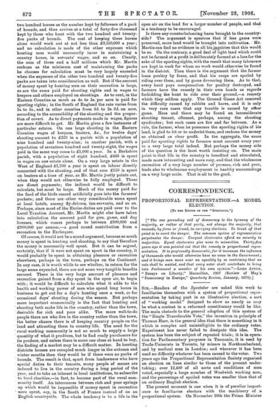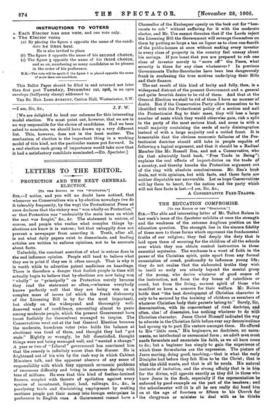CORRESPONDENCE.
PROPORTIONAL REPRESENTATION.--A MODEL ELECTION.
I.TO VIZ EDITOR 01 TIM "Ssscrsroa.'J [" The one pervading evil of democracy is the tyranny of the majority, or rather of that party, not always the majority, that succeeds, by force or fraud, in carrying elections. To break off that point is to avert the danger. The common system of representation perpetuates the danger. Unequal electorates afford no security to majorities. Equal electorates give none to minorities. Thirty-five years ago it was pointed out that the remedy is proportional repre- sentation. It is profoundly democratic, for it increases the influence of thousands who would otherwise have no voice in the Government; and it brings men more near an equality by so contriving that no vote shall be wasted, and that every voter shall contribute to bring into Parliament a member of his own opinion."—Long ACTON, " Essays on Liberty," Macmillan, 1907 (Review of May's "Democracy in Europe," Quarterly Review, January, 1878).] Sin,—Readers of the Spectator are asked this week to familiarise themselves with a system of proportional repre- sentation by taking part in an illustrative election, a sort of " working model" designed to show as nearly as may be what a contest in a reformed constituency would be like. The main obstacle to the general adoption of this system of the "Single Transferable Vote," the invention in principle of Thomas Hare, is the general idea that there is something in it which is complex and unintelligible to the ordinary voter. Experiment has never failed to dissipate this idea. The system has been the subject of repeated trials; it is in opera- tion for Parliamentary purposes in Tasmania, it is used by Trade-Unionists in Toronto, by miners in Northumberland, and by medical men in London; and wherever it has been used no difficulty whatever has been caused to the voter. Two years ago the Proportional Representation Society organised an election on lines similar to those of the present under- taking; over 12,400 of all sorts and conditions of men voted, especially a large number of Woolwich working men, and the percentage of spoiled votes was smaller than that of an ordinary English election.
The present moment is one when it is of peculiar import- ance to familiarise electors with the. machinery of a proportional system. On November 10th the Prime Minister
practically gave a promise to the important deputation which Waited on him that he would initiate an inquiry into the various schemes that have been proposed for electoral reform. -Advocates of proportional representation welcome such an inquiry with enthusiasm; but for their. ultimate success they have not merely to -convince a small tribunal of judicially minded men, but also to produce in the public at large an -intelligent sympathy with their aims and methods.
For the operation of the "Single Transferable Vote," as for that of every other proportional system, it is necessary to have constituencies returning several Members, not less than. three and not more than (say) thirteen, though the maximum number is a matter of practical convenience, not imposed by the inherent conditions of the system itself. These constituencies would naturally be formed out of the large provincial cities, such as Glasgow, Liverpcol, and Manchester, and out of counties, such as Wiltshire or Oxford- shire, the more populous counties, such as Kent or York- shire, being divided into several constituencies. But the single-Member constituency now existing is irreconcilable with any form of proportional representation, and its operation • in crushing minorities, distorting, and sometimes suppressing, majorities, and falsifying popular opinion, is made worse, and not better, by the second ballot. A moment's reflection will -make this clear. For in the single-Member constituency all voters, of whatever shades of opinion, must be represented -by one man only ; which is absurd; for to tell a Free- trader that a Tariff Reformer speaks for him on the Fiscal question would in any rational society appear merely a bad practical joke.
Within these constituencies the simplest form of approach to true representation (and it is that which the Japanese have chosen) would be to let every voter have one vote and to attempt no further elaboration. [The English municipal system, which is the same in principle as that of the sorutin de lisle, and by which each voter has as many votes as there are vacancies, is, of course, indefensible from the point of view of proportional representation, as a bare majority, or, if three parties are in presence, often the largest minority, gets all the seats.]
Now the result of this simple system would be that in a constituency returning five Members, a fifth* of the electors acting together would be sure of electing. a candidate. For the other four-fifths could not distribute their votes among five candidates, so as to give to each of the five more than a fifth of the votes. But here occurs the difficulty that a .popular candidate may do harm to his own party by drawing to himself a large majority and leaving the other candidates of his party almost voteless. Thus a poll in a five-Member constituency of 10,000 voters where there ar•e 6,000 Unionists, 2,000 Liberals, and 2,000 Labour men might result thus :— First Unionist ...
First Liberal. ...
First Labour Man ... Second Labour Man Second Liberal ...
Second Unionist ...
Third Liberal ... Third Labour Man...
Third Unionist ... ... 60
plainly unjust result; the popularity of the first Unionist has lost his party two seats. It is at this point that the necessity for the transferability of the vote appears. Why not allow the supporters of the first Unionist to have their votes, in so far as not wanted to make the candidate of their first choice secure of election, carried over to the other candi- dates whom they favour• ? And this is what is done by the system of the "Single Transferable Vote." The elector indicates his preference by marking his candidates 1, 2, 3, and so on, in order of preference (this is an optional proceeding on his part; to vote validly he need only mark one name with a 1), and the returning officer makes the transfer accordingly.
The task of the elector is thus simplicity itself ; be must mark one candidate with a 1, and he may mark further candidates
with 2, 3, and so on.
The task of the returning officer involves more care than
• NOTE.—In reality the fraction—the so-called " quota "—is less, and in the case supposed is one-sixth plus one. For just as in a single•Member con. stituency one-half plus one of the eleotors is sure to return its candidate, so in a two-Member constituency one-third plus one is equally sure, and so on. So the general formula for the quota is,—divide the total votes by the number of vacancies and add one to the result I tractions are neglected.
... 5,500
... 902
• 901 Elected
• 899 ... 898 Not Elected the present system. He has, in the first instance, to ascertain the " quota." In accordance with the explanation already given, this, in our imaginary five-Member constituency
10,0e
of 10,000 voters, would be (5 + 1) = 6 + 1, or (neglecting fractions) 1,667. He then declares elected those candidates who have the quota, and proceeds to transfer the votes given them in excess of the quota to the candidates marked as next preference by the electors. He does this in such a way as to give each transferee the same proportion of surplus votes as that transferee has of next preferences in the whole body of votes cast for the first candidate. Thus, if one-half the electors who marked A as No.1, marked B as No. 2, and Alias a surplus of 1,000, B will get 500 transferred votes. He then declares elected those candidates who, as a result of the transfer•, have obtained the quota. This operation in the example given would result in electing all three Unionist candidates, if the electors have so desired.
Lastly, if vacancies still remain, the returning officer eliminates the candidates lowest on the poll one after the other, beginning at the bottom, and transfers their votes to the electors' next preferences. This is done on the theory that their election is practically hopeless, and that the supporters ar•e asked and answer the question : " The candidate of your first choice being hopeless, whom do you prefer ? " This process of elimination goes on until all the vacancies are filled by the election of candidates with the quota, or until the number of surviving candidates is the same as that of the unfilled vacancies, in which event the candidates not eliminated are declared elected. The conclusion of the whole matter is that the returning officer must bring care and a knowledge of the four rules of arithmetic to the execution of Ilia duties.
The ballot-paper given below may be allowed to speak for itself. Five Members are to be elected for an imaginary constituency. The candidates are well-known public men, chosen as representative of the main divisions of political opinion ; a real constituency would hardly enjoy so dis- tinguished a body of candidates ; but in an example like this an unknown candidate could not be put forward, as he would have no opportunity of making himself known to the electors.
Readers are asked to fill in the ballot-paper, cut it out, and post it to the Caxton Hall, Westminster, as directed. The same opportunity is being offered to-day to the readers of newspapers of all shades of political opinion in Great Britain. The votes will be counted at Caxton Hall on Thursday evening next, December 3rd, and the result announced the following morning. The counting will be in the presence of representatives of the Press and of others who may be interested, and will be carried through by volunteer helpers of the Proportional Representation Society :—
Order of Prefer- mice.
Names of Candidates.
ASQUITH, The Rt. Hon. H. H.
BALFOUR, The Rt. Hon. A. J.
BURT, The Rt. Hon. Thomas
CECIL, Lord Hugh
I HENDERSON, Arthur
1 JONES, Leif i JOYNSON-HICKS, W.
LLOYD GEORGE, The Rt. Hon. D.
LONG, The Rt. Hon. Walter H.
MACDONALD, J. Ramsay
SHACKLETON, David SMITH, F. E,
(For "Instructions to Voters" see next page.)
INSTRUCTIONS TO VOTERS
A. Each Elector has one vote, and one vote only.
B. The Elector votes
(a) By placing the figure i opposite the name of the candi- date he likes best. He is also invited to place (b) The figure 2 opposite the name of his second choice.
(c) The figure 3 opposite the name of his third choice, and so on, numbering as many candidates as he pleases in the order of his preference.
N.B.—The vote will be spoilt if the figure 1 is placed opposite the name of more than one candidate.
This Ballot Paper should be filled in and returned not later than first post Tuesday, December 1st, 1908, in an open envelope (halfpenny stamp) addressed to Tap RT. HON. LORD AVEBURT, Caxton Hall, Westminster, S.W.
[We are delighted to lend our columns for this interesting model election. We must point out, however, that we are in no way responsible for the choice of candidates. Had we been asked to nominate, we should have drawn up a very different list. This, however, does not in the least matter. The mechanism of election is the important thing in a working model of this kind, not the particular names put forward. In a real election each group of importance would take care that it had a satisfactory candidate nominated.—En. Spectator.]




















































 Previous page
Previous page